- within Corporate/Commercial Law topic(s)
- in United States
- within Corporate/Commercial Law, Litigation, Mediation & Arbitration and Privacy topic(s)
- with readers working within the Law Firm industries
ABSTRACT
We are living in a world where technology and innovation is at its peak and while adapting to such advancements is the way ahead in life, one also has to recognize and be aware of the climate change crisis the planet is facing due to human activities. The climate crisis is an accumulated misfortune associated with exploitation of biological resources, overutilization of energy sources and combustion of harmful gases, etc. Being a mega-biodiverse nation, India plays a significant role with regards to its contribution to the world's biological diversity. By aligning with international conventions, agreements and treaties, India gradually worked upon its commitment for protection and conservation of biodiversity and natural resources. Thereafter, since 2002, the nation has accounted for significant contributions made towards protection of our natural habitat. The conservation plans and mitigation strategies are implemented keeping in mind the ever-evolving changes taking place in our surroundings. Understanding the gravity of the situation, the nation has seen active involvement in biodiversity protection at all levels including government, judiciary, professionals, activists/ researchers, etc. For India, conservation of biological diversity is essential for various reasons, especially since it provides for the livelihood of people and assists with alleviation of poverty.
TABLE OF CONTENT
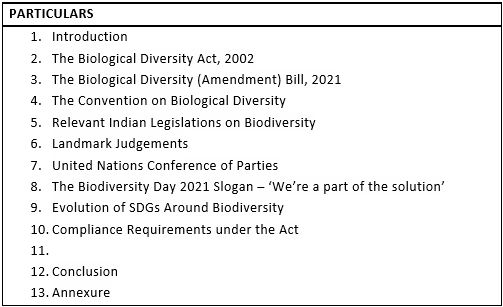
- INTRODUCTION
India is one of the 17 mega-biodiverse countries in the world and accounts for 7-8 percent of the world's biodiversity with 2.4 percent of the Earth's surface area1. This contribution may be attributed to the presence of the vast variety of genetic as well as plant & animal species alongside other natural resources, which have been and continue to be utilized to the extent of exploitation to gain commercial benefits. While the loss of biodiversity is a natural process, the over-utilization of resources by human beings has rapidly increased, so much so that it has led to the extinction of many distinct species and genetic resources. For decades now, unregulated urbanization, the swift increase in industrialization and other human activities resulted in consequential damage to the environment. This deterioration of the ecosystem led to the constitution of a legal statute, focused on the restoration and survival of the biological diversity in India.
- THE BIOLOGICAL DIVERSITY ACT, 2002
2.1. Implementation of the Biological Diversity Act, 2002 –
Taking into view the adverse impact of human activities on the environment and as an attempt to uphold its commitment under the UN Convention on Biological Diversity, 1992, the Biological Diversity Act, 2002 (the Act) was brought into force by the Indian lawmakers with the primary objective to preserve biological resources, take appropriate action for mitigation of risks and effectively address the issues concerning equitable sharing benefits pertaining to utilization of these resources. While facilitating equitable use and benefits, the Act provides for sustainable use of resources via a three-tier authority system i.e. the National Biodiversity Authority (NBA), the State Biodiversity Board (SBB) and the Biodiversity Management Committees (BMC). Each of these authorities has a distinct role in the regulation of activities and ensuring the conservation, sustainable use and equal-sharing benefits.
2.2. Prior to Biological Diversity Act, 2002 –
The Constitution of India, Art 51 makes it an obligation for the nation to respect international treaties and agreements. Accordingly, India was under the obligation to align with the Convention on Biological Diversity, to which the nation became a signatory in May, 1994. The nation's alignment to its international obligations to protect biodiversity was reiterated by the judiciary in the case of T.N. Godavarman Thirumalpad v. Union of India2. The Supreme Court observed that it is the role of the Government to take into consideration international conventions and norms while construing the domestic law. Furthermore, the apex court also stated that it was the constitutional duty to preserve the forest cover and species for both present and the future. Subsequently, the Biological Diversity Act in 2002 was followed by the Rule in 2004 as part of its international obligations.
2.3. Post Biological Diversity Act, 2002 –
The previous decade witnessed a substantial movement in terms of legally voicing the adverse effect of human activity on biological diversity. In order to facilitate a first instance forum, the National Green Tribunal was established as a specialized body to effectively and expeditiously respond to environmental jurisprudence in the country. Moving forward, it is believed that pre-planning for biodiversity issues by way of policy interventions and financial commitments can result as an important source of minimising adverse environmental impact.
2.4. Latest Development –
As per the United Nations Environment Programme, India is amongst the top performers when it comes to effectively addressing the objectives of the Convention on Biological Diversity. The Act provides for mandatory creation of the People's Biodiversity Registers, which shall be prepared by the Biodiversity Management Committees in consultation with the local people. It is imperative to understand that the Registers are not mere documentations, but are, in fact, a source to understand the ground reality and accordingly develop an agenda for protection and conservation of biodiversity. Recently in 2021, the Haryana State Biodiversity Board constituted over 6000 committees to conserve biodiversity and further document traditional knowledge pertaining to biological resources.
In 2012, India ratified the Nagoya Protocol, which provides a platform to facilitate smooth exchange of information pertaining to the genetic resources, the Access and Benefit-sharing Clearing-House established to provide for implementation of the Protocol. Subsequently, in 2013, the Madhya Pradesh State Biodiversity Board ordered companies to use State bio-resources for commercial use and disclosed benefits arising out of such commercial use. The order further enlisted certain permissions to be obtained by companies prior to extraction of biological resources for commercial purposes.
In 2019, the Ministry of Environment, Forest and Climate Change (National Biodiversity Authority) issued a notification3 providing Guidelines on Access to Biological Resources and Associated Knowledge and Equitable Sharing of Benefits Regulations, 2019. The Regulations suggest that the State Biodiversity Board are bound to adhere to the provisions thereunder and also imposed certain obligations on researcher/ scientists pertaining to discovery in India, with a repository outside India.
Furthermore, the UN Convention on Biological Diversity Secretariat released a new structure called the Global Framework for Managing Nature Through 20304 to facilitate a Paris-style UN agreement focused on issues related to biological diversity and the plan of action to effectively preserve and protect nature and its resources. The newly introduced framework aims to enhance the urgent and transformative action by Governments and the entire society, including indigenous people and local communities towards mitigation of risks pertaining to biodiversity.
- BIOLOGICAL DIVERSITY (AMENDMENT) BILL, 2021
In December, 2021, Mr. Bhupendra Yadav, Minister of Environment, Forest and Climate Change, with the purpose of enhancing the existing legislation made amendments in alignment with current environmental needs, the Biological Diversity (Amendment) Bill, 2021 introduced in Lok Sabha. Some of the material changes under the Amendment Bill are –
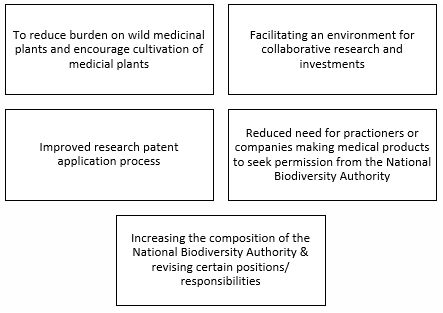
Pursuant to its introduction, the Amendment Bill has been subject to scrutiny, with one of the major concerns being the decriminalization of certain provisions thereunder. Proposing to decriminalize violation of substantive provisions of the legislation, the Amendment Bill also provides for creation of two separate authorities i.e. Biodiversity Authorities at both Central and State levels, which under the Biodiversity Act, 2002 was bifurcated as National Biodiversity Authority and the State Biodiversity Authorities. These authorities had the power to lodge complaints (FIR), followed by magisterial enquiries in incidents of violation of any of the provisions of the Act. However, the Amendment Bill proposes to withdraw the power given to the National Biodiversity Authority to file a FIR against a defaulting party for violation. Moreover, the proposed Bill provides for the creation of an inquiry officer, who following an inquiry, can impose a penalty of up-to Rs. 1 crore in cases of continuous violation. It is also being argued that the Amendment Bill is more focused on prioritizing intellectual property and innovation that the agenda for conservation of biological resources seems to have taken a back foot. Another concern is the proposed provisions allowing AYUSH practitioners' access to biological resources for certain purposes without obtaining prior approval from the State biodiversity boards. However, with regards to foreign investment in research biodiversity, the investment will be required either from an Indian company involved in biodiversity research or from a foreign entity only upon approval of the National Biodiversity Authority. Taking into consideration the proposed provisions which, basis its repose so far, is subject to further amendment. Nonetheless, the ultimate expectation is to have an improved legislation in place that helps take the biodiversity regime in Indian to a higher level with a conscious balance, maintaining interests of all stakeholders.
- THE CONVENTION ON BIOLOGICAL DIVERSITY
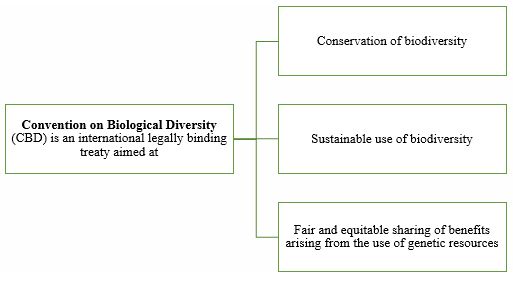
The CBD covers various levels of biodiversity i.e. ecosystem, species and genetic resources and is related to different domains of biodiversity ranging from science, culture, business, education, etc. The governing body of CBD is the Convention of Parties (COP), which serves as the ultimate authority of all Parties and is responsible for reviewing progress, setting targets and constituting robust action plans.
In February, 2020, India hosted its first COP in Gujarat, whereby the theme of the 13th Meeting of the COP was Migratory Species of Wild Animals. Upon conclusion of the Conference, India was seen to have committed to a number of resolutions and decisions on threats to the migratory species and effective ways to help conserve their habitat across the globe.
- RELEVANT INDIAN LEGISLATIONS ON BIODIVERSITY
5.1. Forest Conservation Act 1980 – The Act is aimed at the protection of forest land by managing and controlling the rate of deforestation. Notably in October, 2021, the Union Ministry of Environment, Forest and Climate Change released a consultation paper proposing amendments to the Act focused on providing ease of doing business.
5.2. Fisheries Act, 1897 – The Act provides for stringent provisions against destruction of fishes by way of explosives, poisoning of water, etc.
5.3. Mining and Mineral Development Regulation Act, 1957 – With the primary objective to regulating the mining sector, the Mining and Mineral Development Regulation Act 1957 was established. It details down the process and conditions required for acquiring licence pertaining to mining or exploring other business prospects in India.
5.4. Wildlife Protection Act, 1972 – With the primary objective of prohibiting the hunting of wild animals or endangered species, the Wildlife Protection Act, 1972 also captures protection of specified plants by prohibiting its uprooting or cutting.
- LANDMARK JUDGEMENTS
6.1. Late T.N. Godavarman Thirumalpad was also known as the "Green man", in the case of T.N. Godavarman Thirumalpad v. Union of India5, played a crucial role in promoting environmental protection. He had initiated a case by filing a writ petition which turned out to be a landmark Supreme Court case on the protection of India's forest land. He lodged the writ petition with the objective of protecting and safeguarding the forest land of Nilgiris, which was being exploited, thus resulting in deforestation by unlawful timber activities. This very case is known as "The Forest Case of India" because the Apex court issued directions in relation to the use of forest and its resources sustainably and in conjunction with that, to incorporate a self-monitoring mechanism. The Supreme Court stated that an implementation system should be formed at the State and Regional level to control the transportation of timber. It highlighted the need for promoting and maintaining forest productivity, which resulted in closure of numerous timber industries.
6.2. The case of Intellectuals Forum Tirupathi v. State of A.P6, raised two questions – firstly, that does it fall on this court to lay down the law relating to the use of public lands and natural resources which had a link to environment of a particular area by the government. The Supreme Court stated that the Constitution of India, Art 21 observes that environmental protection is a fundamental right and accordingly, protection of biological resources shall be undertaken. It gave a reference of a case which was passed by this very court that the Government, on one hand, should consider the importance of public projects for the betterment of people's living conditions and to preserve the social and ecological balance to avoid deforestation.
6.3. The case of Rural Litigation and Entitlement v. State of U.P. & Ors7 ., is also known as the 'Dehradun Valley Litigation'. The case pertains to illegal activity of quarrying and limestone being extracted by blasting out the hills with dynamite. Such activities resulted in lack of vegetation, landslides, destruction of homes, agricultural land and death including the villagers and their cattle. The case demanded for the apex court to take a decision that provides a framework for sustainable, resilient environment and ecological integrity. Furthermore, the Court reiterated the Constitution of India, Art 21, that the right to wholesome environment is guaranteed under the right to life and personal liberty.
6.4. Lalit Miglani v. State of Uttarakhand8 case is related to the Ganga pollution issue. As part of the PIL, Lalit Miglani contended gross failure on part of the government authorities including both the Central and the State towards the discharge of their statutory duties for prevention of pollution in river Ganga. The High Court of Uttarakhand recommended the Union of India to frame a law exclusively to save Ganga from extinction. The Court held that every citizen has a right to clean water and emphasized the rapid deterioration of the quality of the river. The court made certain mandatory directions which included (i) a direction to the Union of India to establish an inter-State Council under the Constitution of India, Art 263 and various directions towards the establishment of Sewage Treatment Plants; (ii) directions for taking action against / closure of polluting industries, to take actions against Ashrams and other establishments that let out untreated sewage into the river, etc.
6.5. In the case of Indian Council for Enviro-Legal Action v. Union of India9, the petitioner, an environmental association filed a writ petition regarding the issue on miseries of individuals residing in a village called Bichhri Village which was occupied by industries of chemical plants. The issue of the case is that the opportunity of increasing profit margins come at the cost of potentially causing pollution in the area. The court included accountability and remuneration to the people affected from environmental deterioration to the things that were already mentioned in the case of M.C. Mehta v. Union of India as absolute liability rule for damage caused to the environment. Accurately interpreting the 'Polluter pays' principle, the Court drew attention to the fact that there is almost no stress between individual liberty, economic prosperity, private ownership of a property, and adequate environmental sustainability.
- UNITED NATIONS CONFERENCE OF PARTIES
7.1. Conference of Parties 15 (COP15) –
The Convention on Biological Diversity came into effect on December 29, 1993, to amplify efforts towards conservation of biodiversity, its sustainable use and efficient utilization of available resources. So far, there have been 14 meetings conducted by the governing body of the Convention. The latest meeting i.e. COP15 (Fifteenth meeting of the Conference of Parties) was scheduled to be conducted in two parts and accordingly, phase one was held virtually in Kunming, China from October, 11 to 15, 2021, whereas phase two is expected to be conducted in-person in Kunming from April 25 to May 8, 2022. Phase one of the event addressed the critical areas to be worked upon to advance on the path towards sustainable development. With close to 3000 delegates participating in Kunming and 2000+ connecting online, set the momentum for the adoption of an effective post-2020 global biodiversity framework, which is due to be agreed in 2022. Furthermore, some of the significant commitments made during the event include the Government of China establishing a 1.5 billion-yuan (c.$.233 million) Kunming Biodiversity Fund and the European Union doubling external funds for biodiversity. Countries like France, Great Britain and Northern Ireland committed to spending a significant portion of its climate funds towards protection of biodiversity.
7.2. Conference of Parties 26 (COP26) –
The Conference of Parties, more commonly known as COP, is the apex decision-making body for implementation of the United Nations Framework Convention on Climate Change (UNFCCC). Its latest event COP26 took place over a two-week period in Glasgow, Scotland, from 31st October to 12th November 2021. While many may have considered COP26 as yet another international summit on climate change crisis, however, it held higher significance in the global community, as a pivotal movement focused on climate change/ finance. As part of the commitments made at COP26 this year, the UK pledged £290 million to help poorer countries cope with the adverse impact of the climate change crisis and further, also help Asian and Pacific nations plan and invest in conservation and protection of biodiversity. Moreover, "Under 2 Coalition" was announced at COP26, about 68 signatories signed up to a range of new cross-sector actions to be taken this decade to decrease emissions, increase climate resilience and protect biodiversity. During the event, the Hon'ble PM of India, Narendra Modi suggested a new mantra for sustainable development, 'LIFE' i.e. Lifestyle for Environment. The lifestyle patterns and human activities play a major role in climate change and therefore, there is an urgent need for us to come together and stride towards LIFE as a movement for achieving sustainable development.
- THE BIODIVERSITY DAY 2021 SLOGAN – "We're a part of the solution"
In December 2000, May 22 was proclaimed as the International Day for Biological Diversity (IBD) by the UN General Assembly. The purpose was to create awareness, recognition and better understanding of issues related to biodiversity. As a practice of the IBD celebration, the Secretary of the Convention on Biodiversity assigns a theme/ slogan each year, which is determined by the momentum created around the previous year's theme. In this case, the slogan for 2020 was "Our solutions are in nature", which this year is followed by "We're a part of the solution". On account of the covid-19 outbreak, the IBD was celebrated virtually to raise global awareness on the need for protecting biological resources and conservation of the biodiversity that shapes our environmental structure.
As a milestone effort ahead of the IBD, one must take note of the two-day "Leaders' Summit on Climate" which was convened by President Joe Biden on April 22nd and 23rd, 2021. The participants at the Summit recognized and abundantly spoke on the power of collaboration. They emphasised that joining forces at a global level was the way forward to achieve targets of clean energy consumption, carbon footprint reduction and overall economic growth, which is also sustainable for the planet.
- EVOLUTION OF SDG PRINCIPLES AROUND BIDOVERSITY
Over the years, multiple studies have suggested that the ecosystem has a direct relation with human needs. As an outcome of the UN Conference in Brazil 2002, global commitments were made and targets were set to work towards "the future we want". Furthermore, as part of COP21 i.e. Conference of Parties 21, which took place in Paris, 2015 was instrumental in the configuration of the Paris Agreement. It marked a substantial move towards the fight against global climate crisis and comprises 194 parties committed to addressing issues pertaining to global risk in temperature levels. Consequently, the Paris Agreement can be said to have led to the formulation of the Sustainable Development Goals (SDG). The 17 SDGs are recognized as an urgent call for action to collectively commit to the global 2030 agenda for sustainable development.
Biodiversity is essentially the epicentre of most economic activities and globally a relatively high percentage of the human population is dependent on the natural resources for its survival. And while, not all 17 Goals have a direct relationship with restoration and conservation of biodiversity; sustainable living can be said to underpin biodiversity. The applicable SDGs include –
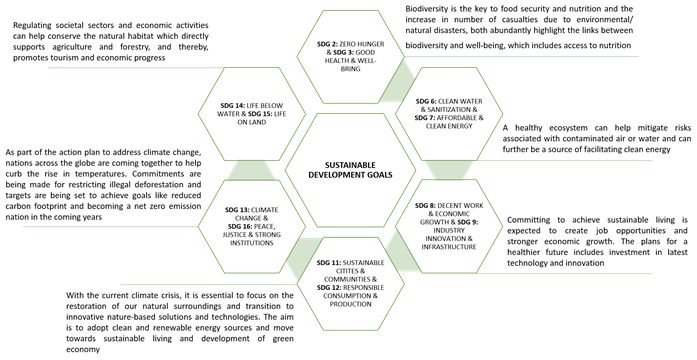
- COMPLIANCE REQUIREMENTS UNDER THE ACT
10.1. Prior Approval – Under provisions of the Act, sec 3, only upon prior approval sought by the NBA, can one obtain access to biological resources in the country or associated knowledge thereto for research or commercial utilisation or bio-survey or utilization. Similarly, under the Act, sec 4, any exchange of research information transferred without approval of the NBA is strictly prohibited.
Even in the case of intellectual property rights, the Act covers such applications under sec 6, which makes it essential to seek approval of the NBA, who while granting such approval has the right to levy benefit-sharing fee or royalty or impose certain conditions on the distribution of the rights for commercial purposes. When referring to Indian researchers, no prior approval or intimation to access biological resources is required for the purpose of conducting research. However, if and when such research or result thereto is used for commercial purposes, the same requires prior approval by the SBB. The Act, sec 7 provides for prior approval of the respective SBB to enable access to biological resources of the country for commercial utilization.
It may be pertinent to note that the legislation exempts collaborative research projects from seeking approval under the Act, sec 3 and sec 4; as long as the project conforms the policy guidelines issued by the Central Government and have commercial utilization of the same. The NBA during its 23rd meeting on February 28, 2012, voted in favour of initiating legal recourse against the multinationals along with others for the alleged violation of the provisions of the Act and illegally accessing and genetically modifying the Indian variants of brinjal to produce Bt Brinjal. And in October, 2013, the Karnataka High Court initiated the continuation of criminal proceedings against the accused, which was put on hold earlier that year.
10.2. Offences & Penalties - In case the offender is a company incorporated under law, the directors and key managerial personnel of such an enterprise shall be deemed guilty of the offence, unless it can be proven that the offence was committed without their prior knowledge.
The Act stipulates that all offences shall be cognizable and non-bailable, which implies that all offences under the Act shall be punishable with imprisonment and that a police officer may arrest any alleged offender without a warrant. Any contravention of the Act, sections 3, 4 and 6 can attract punishment amounting to imprisonment of 5 years or fine of INR 10 lakhs and in case of damage over and above ten lakh rupees, then the fine may commensurate with the damage caused or both. Any non-compliance with the Act, sec 7 or violation of an order issued under the Act, sec 24(2), may result in a 3 years imprisonment, or fine of INR 5 lakhs, or both.
In the case of Divya Pharmacy v. Union of India and Ors10, the issue was whether or not the SBB has the authority to impose a "Fair and Equitable Benefit Sharing" (FEBS) as one of its regulatory functions on the Indian entities using Biological Resources. The Court observed that given the statutory functions of the SBB under the Act, sec 7 read with sec 23 and the power of NBA to frame necessary regulations as provided under the Act, sec 21; the SBB is empowered to demand the FEBS from the petitioner for making use of biological resources for commercial purposes. Furthermore, the judgment also recognized the indigenous and local communities, who either grow 'biological resources', or have traditional knowledge of these resources, to be beneficiaries under the Act.
In the case of Chandra Bhal Singh Vs. Union of India & Ors11, the petitioner sought the intervention of the National Green Tribunal to impose orders for the effective implementation of provisions of the Act. In 2018, orders were passed directing the BMCs to adhere to the requisite compliance provisions and the Ministry of Environment, Forest and Climate Change along with the NBA required to monitor the progress of the order. Subsequently, the order resulted in the increase of effective implementation under the Act; following which the Tribunal directed 100 percent compliance by the BMCs till the end of January, 2020. In order to raise a sense of seriousness, the Tribunal assigned a fine of INR ten lakhs per month for any default in compliance with the provisions of the Act from February, 2020.
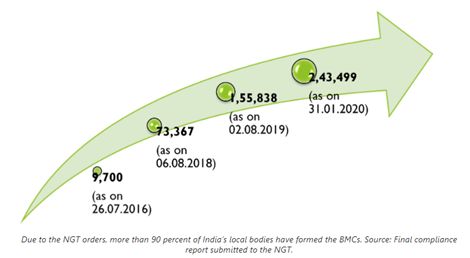
Following the final report submitted to the Tribunal, in March, 2020 the rate of effective compliance implementation was at 90 percent. While issuing compensation to be paid by defaulting states for non-compliance, the Tribunal stated that the States were restricted from seeking incompetence or inability of carrying out the mandate under law as leniency towards non-compliant states may negatively impact the conservation of biodiversity.
- MAJOR BIODIVERSITY PROJECTS IN INDIA
11.1. Project Elephant - The Government of India's Ministry of Environment and Forests started Project Elephant in 1992 to grant financial and technical assistance to states' wildlife management efforts for their free-ranging populations of wild Asian elephants. The initiative seeks to safeguard elephants, their habitats, and migration corridors in order to ensure their long-term survival in their native settings. Project Elephant's other objectives include funding elephant ecological and management research, raising conservation awareness among locals, and improving veterinary care for captive elephants.
11.2. Biodiversity Conservation and Ganga Rejuvenation - By restoring Ganga's ecological integrity, this initiative is an important aspect of NMCG's mission for Ganga Rejuvenation. A sustainable river restoration project should be centered on the ecological feature of a healthy river, which includes aquatic biota as good indicators of river health. The project also aims to set up a Ganga Aqualife Conservation Monitoring Centre at WII Dehra Dun for science-based conservation planning and information dissemination.
11.3. Shiwalik Biodiversity Park (SBP) – Spread across 50 hectares of land, SBP is the biggest biodiversity park in the State, aimed at conservation of the natural landscape. The project is expected to be constructed in three phases over the next five years, having over 33 conservation concepts.
11.4. Project Dolphins – in the year 2021, India embarked on the journey towards enumeration of dolphins, which is to be carried out every three years. The project was initiated by PM Narendra Modi in 2020 and the final report is expected to be made available by June-July 2022.
11.5. National Mission on Sustainable Habitat – The mission is aimed at helping cities transition to use of sustainable resources and improving energy efficiency.
- CONCLUSION
It is imperative to ensure the conservation and protection of biodiversity for sustenance in current and all times to come. A focused and collaborative effort today can serve as an insurance policy in the coming years, thereby, safeguarding and providing sustainable support systems for life on earth. Our survival on this planet is directly proportionate to the existence of nature, thereby, giving biological diversity immense value in the social and cultural spheres. Collective and dedicated initiatives aimed at integrating sustainable living are likely to yield substantial outcomes on the preservation of the environment.
- ANNEXURE
13.1. The following is the list international agreements focused on conservation and protection of biodiversity to which India is a party –
13.1.1. Bonn Convention on Migratory Species
13.1.2. Convention on Biological Diversity
13.1.3. Convention on International Trade on Endangered Species
13.1.4. Ramsar Convention on Wetlands
13.1.5. World Heritage Convention
13.1.6. World Trade Organization
13.1.7. UN Framework Convention on Climate Change
13.1.8. UN Convention to Combating Desertification
13.1.9. UN Commission on Sustainable Development
13.1.10. UN Law of the Seas
13.2. The following are some of the policies pertaining to safeguarding and committing to preserve the environment and biodiversity –
13.2.1. National Forest Policy
13.2.2. National Biodiversity Action Plan (2009)
13.2.3. National Agriculture Policy
13.2.4. National Water Policy
13.2.5. National Environment Policy (2006)
Footnotes
1. The National Biodiversity Authority, Question 3, Apr. 25, 2018, http://nbaindia.org/content/19/16/1/faq.html.
2. 39 T.N. Godavarman Thirumalpad v. Union of India, (2002) 10 S.C.C. 606.
3. The 2019 Guidelines deal with how benefit sharing obligations are to be determined and imposed by the National Biodiversity Authority (Mar. 10, 2021).
4. UN Convention on Biological Diversity, (2021), Global Framework for Managing Nature Through 2030.
5. T.N. Godavarman Thirumalpad v. Union of India, (2002) 10 S.C.C. 606.
6. Intellectuals Forum Tirupathi v. State of A.P, (2006) 3 S.C.C. 549.
7. Rural Litigation and Entitlement v. State of U.P. & Ors., 1985 AIR 652.
8. Lalit Miglani v. State of Uttarakhand 2017 S.C.C. Online Utt 392
9. Indian Council for Enviro-Legal Action v. Union of India, (1996) 3 S.C.C. 316.
10. Divya Pharmacy v. Union of India and Ors., (2018), S.C.C. Online Utt 1035.
11. Chandra Bhal Singh Vs. Union of India & Ors, (2020) Original Application No. 347 of 2016 (India).
This article is for information purpose only. It is not intended to constitute, and should not be taken as legal advice, or a communication intended to solicit or establish commercial motives with any. The firm shall not have any obligations or liabilities towards any acts or omission of any reader(s) consequent to any information contained herein. The readers are advised to consult competent professionals in their own judgment before acting on the basis of any information provided hereby.



